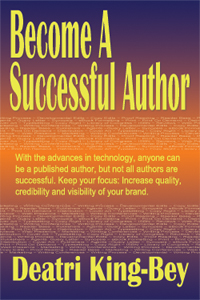 I can not tell you how many times I’ve heard something on these lines: “I just received a bad review. Readers have a right to their opinion, but [FILL IN THE BLANK WITH SOMETHING NEGATIVE]… Will you go to Amazon and check that the review wasn’t helpful?” and/or “… will you report this review as abusive?”
I can not tell you how many times I’ve heard something on these lines: “I just received a bad review. Readers have a right to their opinion, but [FILL IN THE BLANK WITH SOMETHING NEGATIVE]… Will you go to Amazon and check that the review wasn’t helpful?” and/or “… will you report this review as abusive?”
Next thing you know, you have other authors chiming in, belittling and bashing the reviewer, searching for anything to discredit the reviewer from a typo to saying the they are just “hating.”
It’s truly upsetting. And even worse, I’ve seen this type of thing happen in reader loops. Stop the insanity.
I understand one author supporting another author. I commend this, but be careful of the type of support you give. Just as criticism can be constructive and destructive, so can support. It’s just more difficult to recognize destructive support. And as an author with over ten books published, trust me when I say I’ve had my share of bad reviews and it SUCKS ROCKS. I may want to throw those rocks at the reviewer, but I don’t. And that’s not always an easy task.
If you receive a review you are not happy with—DO NOT contact the reviewer and send out blasts about how horrible this reviewer is and how they are out to get you. Do not contact your friends and family and have them write all types of negative comments on the review. Okay, so I’m being a little melodramatic—not really. I’ve actually seen this type of behavior happen. Everything you do in regard to your book(s) should be to strengthen your brand. You may think you are defending your work, but when you react this way you tarnish your brand and lose credibility. Does this mean that if a review is filled with inaccuracies you can not speak out? Heck no.
For my title Black Widow and the Sandman that I wrote under the pseudonym L. L. Reaper, a prominent journal had it categorized as Christian Fiction (it’s suspense and far from Christian Fiction). There were serious inaccuracies about characters, plot and setting. It was obvious the reviewer had not read the book, so some would think that I had the “right” to put her on full blast. Yes, technically, I had the right, but did I exercise this right? No. Why? Because my acting out would have made me look small and unprofessional. I contacted the journal and let them know of the inaccuracies and besides apologizing profusely, they ran a correction. Lesson, if your book is reviewed by a team or organization and there are inaccuracies, then it is okay to contact the organization and have the issues corrected. Most of the time the organization will correct the error because they do not want to risk losing credibility, but there are times that they don’t make the change and it will annoy you, but don’t worry about items out of your control. For example, there is, actually WAS, another prominent review magazine that reviewed one of the books that I edited. The name of a city was in the title of the book. The book was not set in that city. The reviewer of this magazine had the setting for the city wrong (she said it was set in the city that was in the title) and other items wrong. Needless to say, the magazine was contacted and they chose not to print a correction. This WAS a popular magazine at the time but saw a sharp decline in sales and not only because of more online business. They lost credibility because word got out that they weren’t reading the books that they were reviewing. Readers aren’t stupid. When the reviews have serious inaccuracies, the reader knows what’s up and will not trust reviews from that source.
Okay, so what about reviews from individuals? This can be extremely tricky. EXTREMELY, because you don’t want to look as if you are attacking the reviewer for his/her opinion. Most of the time I say let it go. We will all have bad and or inaccurate reviews from time to time. But if you can’t let it go, only comment on items that aren’t subjective. For example, the reviewer who had the setting for the book in the incorrect city (and also state, but that’s a different matter). I’ve had reviewers angry because my book wasn’t interracial (though the cover clearly showed a Black couple). I’ve had reviewers say a book that had part of its setting in Cuba was actually in Mexico. I know it will be hard, but try your best to let it go. In all of the reviews I’ve been through, I’ve only commented on one about an inaccuracy, and I only did that because it was one of the first reviews for the title. Looking back, I wish I had let that slide because in the big scheme of things, that error didn’t really matter enough to point out.
Now let’s move onto subjective material. I love lemons and would rate them five stars. My cousin hates them and would give them a zero if the rating system would let her. I love the smell of roses but there are those who believe they stink. See what I’m getting at. When you are dealing with opinions, everyone has their right to one. When you and your friends who are trying to support you go into these groups and pounce on a reviewer for his/her opinion, you are telling all readers that if you like lemons, they must like lemons also or there is something wrong with them. And it doesn’t matter that millions of people love the small of roses and there is that one person who doesn’t. That doesn’t make that one person wrong. That means that one person doesn’t like the smell of roses.
Take a step back and try to be objective. Was the reviewer being constructive or destructive? If constructive, then how can you use the reviewer’s points to help in your future writing and/or in the future rewrites for the title in question?
What about the bogus reviews placed by other authors or those out to get you? Sad, but there are authors who feel if they post negative reviews and have others post negative reviews regarding your books, this will somehow increase their sells. Let this stuff roll off your back. Readers aren’t stupid. Have faith in them.
Here we are 1000 words since this article began and the key point is when you get a less than glowing review, let it go. Do not get into back and forth with readers/authors online or even offline at events. In the long run it will hurt your credibility and future sells.
Deatri King-Bey
Please support your fellow authors by sharing posts you find helpful.
Don’t have a copy of Become A Successful Author? What are you waiting for? Become A Successful Author will be used in the “How To Write That Novel” course at Chicago State because it covers everything from branding to writing to editing to formatting and uploading electronic and print books to marketing and so much more. Your time is money. Look at all the time, thus money, you’ll save by ending your search for answers: Purchase Become A Successful Author (eBook) for only $4.99 from: Amazon (US), Amazon (UK), Barnes & Noble or print copies for only $7.99 by using the Contact page of this website and tell Dee know how many copies you’d like and shipping address. She’ll email the ordering information.


